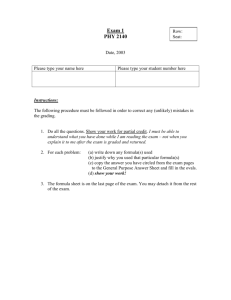Exam 3 (Make-up) Solutions
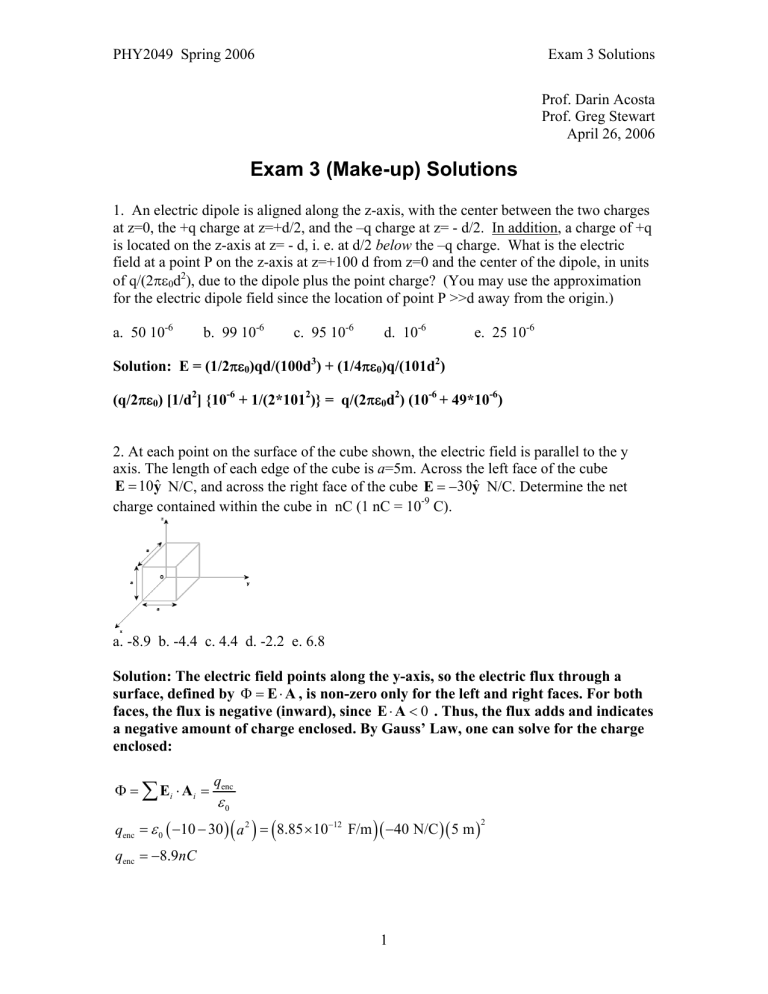
PHY2049 Spring 2006 Exam 3 Solutions
Prof. Darin Acosta
Prof. Greg Stewart
April 26, 2006
Exam 3 (Make-up) Solutions
1. An electric dipole is aligned along the z-axis, with the center between the two charges at z=0, the +q charge at z=+d/2, and the –q charge at z= - d/2. In addition, a charge of +q is located on the z-axis at z= - d, i. e. at d/2 below the –q charge. What is the electric field at a point P on the z-axis at z=+100 d from z=0 and the center of the dipole, in units of q/(2
πε
0 d
2
), due to the dipole plus the point charge? (You may use the approximation for the electric dipole field since the location of point P >>d away from the origin.) a. 50 10
-6 b. 99 10
-6 c. 95 10
-6 d. 10
-6 e. 25 10
-6
Solution: E = (1/2
πε
0
)qd/(100d
3
) + (1/4
πε
0
)q/(101d
2
)
(q/2
πε
0
) [1/d
2
] {10
-6
+ 1/(2*101
2
)} = q/(2
πε
0 d
2
) (10
-6
+ 49*10
-6
)
2. At each point on the surface of the cube shown, the electric field is parallel to the y axis. The length of each edge of the cube is a =5m. Across the left face of the cube
E
=
10 ˆ N/C, and across the right face of the cube E
= −
30 ˆ N/C. Determine the net charge contained within the cube in nC (1 nC = 10
-9
C). a. -8.9 b. -4.4 c. 4.4 d. -2.2 e. 6.8
Solution: The electric field points along the y-axis, so the electric flux through a surface, defined by E A , is non-zero only for the left and right faces. For both faces, the flux is negative (inward), since 0 . Thus, the flux adds and indicates a negative amount of charge enclosed. By Gauss’ Law, one can solve for the charge enclosed:
Φ = q enc
∑
E A i
⋅ = i q enc
ε
0
=
ε
0
(
10 30
) ( ) (
8.85 10
−
12
F/m
) ( − )( )
2 q enc
= −
8.9
nC
1
PHY2049 Spring 2006 Exam 3 Solutions
3. In the figure shown, what is the net electric potential in Volts at point P due to the 4 particles, if V =0 at infinity, q =4.0 fC, and d =9.0 cm (1 fC = 10
-15
C). a. 0.0002 b. 0.0004 c. 0.0016 d. 0 e. 0.0001
Solution: The total electric potential is just the scalar sum of that from all 4 particles. Thus:
V
=
K q d
+
K q d
−
K q d
−
K q
=
K q
2 d
=
0.0002
2 d
4. What is the total capacitance, in units of
μ
F, of the section of circuit shown? All three capacitors have C=5
μ
F.
⎯⎯⎯⎯⎯⎯
| |
⎯⎯⎯⎯
| |
⎯ ⎯
| | a. 3.33 b. 7.5 c. 6.7 d. 2.5 e. 5
Solution: the two C's in parallel add to 10
μ
F. 10
μ
F in series with 5
μ
F gives a C total via 1/C total
= 1/10 + 1/5 => C total
= 10/3
μ
F
5. A cylindrical resistor of radius 0.5 cm and length 2.0 cm is made of material that has a resistivity of 4
×
10
-5 Ω
-m. If energy is dissipated at a rate of 1W in the resistor, what is the potential difference across it, in units of Volts? a. 0.1 b. 10.0 c. 0.01 d. 1.0 e. 0.006
Solution: Resistance, and then voltage drop, is calculated from
R
P
=
ρ
L
A
=
V
2
1
R
(
−
5
) 0.02
π
0.005
2
V PR
=
=
0.01
Ω
0.01
=
0.1
2
PHY2049 Spring 2006 Exam 3 Solutions
S R
⎯⎯⎯⎯
/
⎯⎯⎯
|
| |
⎯
q
0
, C |
|____________________|
6. If the capacitor, capacitance C , starts off with q
0
= 10
-6
Coulomb of charge and R=10
Ω
, after switch S is closed, how long in seconds in terms of C does it take the charge on the capacitor to reach 10
-8
Coulomb? a. 46 C b. 20 C c. 4.6 C d. 2 C e. 0.2 C
Solution: q = q
0
e
-t/RC for q/q
0
= 1/100, have ln(10
-2
) = -t/10C, so t=4.6052 * 10 C = 46 C
7. What is the magnetic field, in units of T, 1 cm from the center of a toroid carrying i=100 A with the following properties: 500 total turns, a distance from the center of the toroid to the inner windings of 10 cm and a distance from the center of the toroid to the outer windings of 12 cm? a. 0 b. 1 c. 0.1 d. 0.01 e. 10
Solution: inside the inner windings of a toroid, B=0, as discussed in class.
8. A charged capacitor (C=5 µ F) is connected across an inductor (L=0.05 H) to form an
LC circuit. The maximum current in the circuit is 2.0 A. What is the maximum charge on the capacitor (some time later)? a. 10
-3
C b. 10
-6
C c. 2
×
10
3
C d. 5
×
10
-4
C e. 0.1C
Solution: In an LC circuit without resistance, the total energy in the circuit is conserved. So we can compute the energy in the circuit given the parameters of the problem, and then set that equal when the current is a maximum (and the charge=0):
U q 2
= +
1
2 C 2
Li
2
in general
=
1
U Li
2
2 max
=
2 q max
2 C
⇒
1
2
( )( )
2 =
0.1 J
=
2 q max (
−
6
2 5 10 F
)
⇒ q max
= −
3
10 C
3
PHY2049 Spring 2006 Exam 3 Solutions
9. Light traveling in air (n air
~ 1.0) is incident on a thick, flat piece of glass (n glass with an angle to the normal of the incident light of 35 o
= 1.5)
. What is the angle
θ
, measured from the normal, of the light in the glass, in units of degrees? a. 22.5 b. 17.5 c. 19.5 d. 12.5 e. 27.5
Solution: Snell's law: n glass
=>
θ
= 22.5 sin
θ
= n air sin35 since n glass
=1.5, sin
θ
=sin35/1.5 = 0.3824
10. An object is placed 20 cm in front of a concave spherical mirror with a radius of curvature of 60 cm. What is the image distance, including the sign? a. -60 cm b. +60 cm c. +30 cm d. -30 cm e. +15 cm
Solution: The focal length of a spherical mirror is given by f = R/2 (positive for concave mirrors, that can form real images in principle). Since R = 60 cm, f = 30 cm. This the object is within the focal length of the mirror. This implies that a virtual image (negative image distance) will be formed on the opposite side of the mirror:
1 1 1 f i p
1 1 1 1
−
1
= − i f p
1
30 20 60 i 60 cm
4

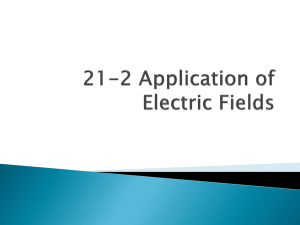
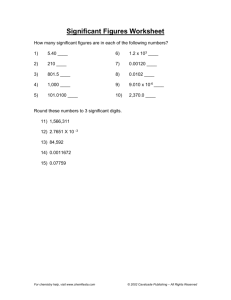
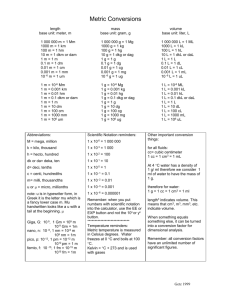
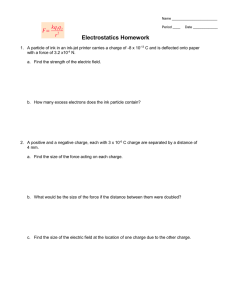
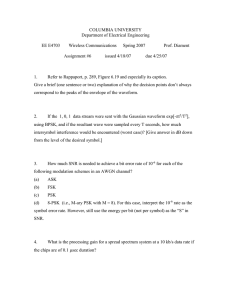
![Sample_hold[1]](http://s2.studylib.net/store/data/005360237_1-66a09447be9ffd6ace4f3f67c2fef5c7-300x300.png)
